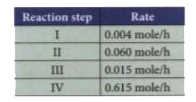For the following reaction through stages I, II and III AI−−→BII−−→CIII−−→D
quantity of the product formed (x) varies with temperature (T) as given. Select correct statement:

Stages I and III are endothermic but II is exothermic
Stages I and III are exothermic but II is endothermic
Stages II and III are exothermic but I is endothermic
Stage I is exothermic but stages II and III are endothermic
The correct Answer is:A
Stage-I (A to B) : The quantity of B is more than that of A. This means formation of B is favoured with increase in temperature, T. Thus stage-I must be endothermic.
State-II (B to C) : The quantity of C is less than that of B. Thus the formation of C is less favoured with an increase in temperature. Hence stage-II must be exothermic.
Stage-III (C to D) : Following from above, stage-III must be endothermic.
Similar Questions
Knowledge Check
For the following reaction through stages I, II and III
AI−−→BII−−→CIII−−→D
quantity of the product formed (x) varies with temperature (T) as given. Select the correct statement.
 AStages I and III are endothermic but II is exothermic.BStages I and III are exothermic but II is endothermicCStages II and III are exothermic but I is endothermicDStage I is exothermic but stages II and III are endothermic.
AStages I and III are endothermic but II is exothermic.BStages I and III are exothermic but II is endothermicCStages II and III are exothermic but I is endothermicDStage I is exothermic but stages II and III are endothermic.Consider isotherms I, II and III:
Select the correct statements. AFor light gases (like H2) isotherm I is obtained.BWhen force of attraction is negligible, isotherms II and III are followed after point B and C.CWhen co-volume is neglected, isotherms II and III are followed A to B or A to C.DAll of these.
AFor light gases (like H2) isotherm I is obtained.BWhen force of attraction is negligible, isotherms II and III are followed after point B and C.CWhen co-volume is neglected, isotherms II and III are followed A to B or A to C.DAll of these.Given the hypothetical reaction mechanism AI−−→BII−−→CIII−−→DIV−−→E and the rate as

Rate determining step isAstep IBstep IICstep IIIDstep IV
In the following sequence :
CH3CH2ClNaCN−−−→(i)Ni/H2−−−→(ii)acetic anhydride−−−−−−−−−→ (iii) , Product (iii) is :
View SolutionConsider the following carbanions
(i)CH3−ӨCH2 (ii)CH2=ӨCH (iii)CH≡ӨC
Correct order of stabilityof these carboanions in decreasing order is
View Solution(I) D-Glucose NaBH4−−−−→X
(II) D-Mannose NaBH4−−−−→Y
(III) D-Fructose NaBH4−−−−→ Product
What will be the product(s) in the third reaction?
View SolutionThe correct set of the products obtained in the following reactions :
(A)RCNreduction −−−−−−→(B)RCN(i)CH3MgBr(ii)H2O
(c)RNC hydrolysis −−−−−−−→(D)RNH2HNO2−−−→
the correct answer is :
View SolutionAmong the following anions, the order of basicity is :
−CH3(I),−NH2(II),OH−(III),F−(IV)
View Solution

